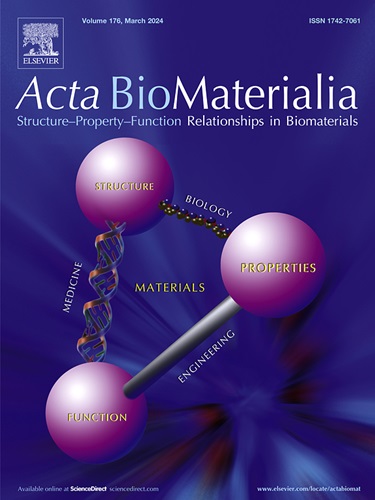A conductive polymer restores connexin43 expression through the suppression of mitogen-activated protein kinases to improve intercellular communication and alleviate atrial fibrillation
IF 9.4
1区 医学
Q1 ENGINEERING, BIOMEDICAL
引用次数: 0
Abstract
Conductive biomaterials have shown promising results for correcting pathological cardiac electrical signaling. However, their mechanisms of operation are still largely unclear. One reason behind disrupted cardiac intercellular communication, though, is lowered expression of the gap junction protein connexin43 (Cx43), which may be alleviated by conductive biomaterials. In this study, we aimed to test this hypothesis, using the self-doping conductive biomaterial poly-3-amino-4-methoxybenzoic acid-gelatin (PAMB-G). An in vitro model was established, in which cardiomyocytes (CMs) were treated with anisomycin, while the in vivo model involved anisomycin-treated mice subjected to electrical pacing to induce atrial fibrillation (AF). Cx43 expression, Ca2+ transient propagation, and CM electrical conduction in vitro, as well as the in vivo effects of PAMB-G on AF, were evaluated; additionally, the underlying molecular mechanisms were identified. We found that anisomycin, at different concentrations, down-regulated Cx43; this was counteracted by PAMB-G, which restored proper Cx43 expression, coupled with improved Ca2+ signal and electrical conduction. Cx43 restoration was due to PAMB-G suppressing anisomycin-induced activation of MAPKs P38 and JNK, which are involved in phosphorylating Cx43 for degradation. Similar observations were also found in vivo, where a PAMB-G patch acted against anisomycin-induced Cx43 downregulation and impaired atrial cell communication, subsequently alleviating pacing-induced AF. Therefore, PAMB-G suppresses MAPKs, in turn upregulating Cx43, leading to improved electrical signal transduction. As a result, modulating the MAPK-Cx43 pathway, such as with PAMB-G, could serve as a potential therapeutic strategy for cardiac arrhythmia.
Statement of significance
Disruption of atrial intercellular gap junction channels, comprised of connexins, leads to atrial fibrillation (AF), the most prevalent arrhythmia, with poor clinical outcomes. Current AF treatments are associated with adverse effects, and only focus on managing symptoms, thereby necessitating innovative treatment strategies. One such strategy is conductive biomaterials, which show promising results for correcting pathological cardiac electrical signaling. We synthesized a self-doping conductive biomaterial, poly-3-amino-4-methoxybenzoic acid-gelatin (PAMB-G), and found that it counteracts against anisomycin-induced connexin43 (Cx43) downregulation, subsequently improving cardiac electrical conduction and alleviating pacing-induced AF. This is owed to PAMB-G suppressing anisomycin-associated activation of mitogen-activated kinases P38 and JNK, which are involved in phosphorylating Cx43 for degradation. Therefore, PAMB-G modulation of MAPK-Cx43 pathway could aid in cardiac arrhythmia treatment.

一种导电聚合物通过抑制丝裂原活化蛋白激酶来恢复connexin43的表达,从而改善细胞间通讯,缓解房颤。
导电性生物材料在纠正病理性心脏电信号方面显示出良好的效果。然而,它们的运作机制在很大程度上仍不清楚。然而,心脏细胞间通讯中断的一个原因是间隙连接蛋白connexin43 (Cx43)的表达降低,这可能通过导电生物材料来缓解。在这项研究中,我们旨在验证这一假设,使用自掺杂导电生物材料聚3-氨基-4-甲氧基苯甲酸-明胶(PAMB-G)。建立体外模型,用大霉素处理心肌细胞(CMs),在体内模型中,用大霉素处理小鼠经电起搏诱发心房颤动(AF)。观察体外Cx43的表达、Ca2+的瞬时传播、CM的电导以及PAMB-G对AF的体内作用;此外,还确定了潜在的分子机制。我们发现,在不同浓度下,大霉素可下调Cx43;这被PAMB-G抵消,它恢复了适当的Cx43表达,同时改善了Ca2+信号和电传导。Cx43的恢复是由于PAMB-G抑制了异霉素诱导的MAPKs P38和JNK的激活,而MAPKs P38和JNK参与了Cx43的磷酸化降解。在体内也发现了类似的观察结果,PAMB-G贴片可抑制异霉素诱导的Cx43下调和心房细胞通讯受损,从而减轻起搏诱导的心房颤动。因此,PAMB-G抑制MAPKs,进而上调Cx43,从而改善电信号转导。因此,调节MAPK-Cx43通路,如PAMB-G,可以作为心律失常的潜在治疗策略。意义声明:由连接蛋白组成的心房细胞间隙连接通道的破坏可导致心房颤动(AF),这是最常见的心律失常,临床结果较差。目前的房颤治疗与不良反应相关,并且只关注于控制症状,因此需要创新的治疗策略。一种这样的策略是导电生物材料,它在纠正病理性心脏电信号方面显示出有希望的结果。我们合成了一种自掺杂导电生物材料聚3-氨基-4-甲氧基苯甲酸-明胶(PAMB-G),发现它可以抵消大霉素诱导的连接蛋白43 (Cx43)下调,从而改善心脏电传导,减轻起搏诱导的心房纤颤。这是因为PAMB-G抑制了与大霉素相关的丝裂原活化激酶P38和JNK的激活,这些激酶参与磷酸化Cx43进行降解。因此,PAMB-G调控MAPK-Cx43通路可能有助于心律失常的治疗。
本文章由计算机程序翻译,如有差异,请以英文原文为准。
求助全文
约1分钟内获得全文
求助全文
来源期刊

Acta Biomaterialia
工程技术-材料科学:生物材料
CiteScore
16.80
自引率
3.10%
发文量
776
审稿时长
30 days
期刊介绍:
Acta Biomaterialia is a monthly peer-reviewed scientific journal published by Elsevier. The journal was established in January 2005. The editor-in-chief is W.R. Wagner (University of Pittsburgh). The journal covers research in biomaterials science, including the interrelationship of biomaterial structure and function from macroscale to nanoscale. Topical coverage includes biomedical and biocompatible materials.
 求助内容:
求助内容: 应助结果提醒方式:
应助结果提醒方式:


